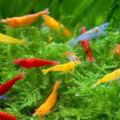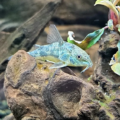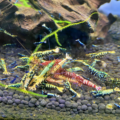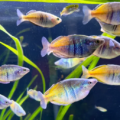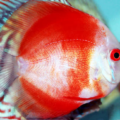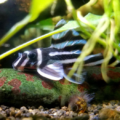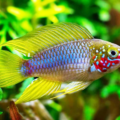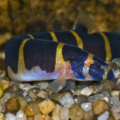Discover all our tips on Leopard Discus care, breeding, and tank setup to create the perfect habitat for this freshwater beauty.

Leopard Discus are one of the most widely kept unique discus varieties among aquarists due to their stunning pattern and graceful demeanor. These unique physical traits make this fish a top selection for hobbyists seeking to add visual interest and a pop of color to their tanks.
In this Leopard Discus fish overview, we’ll help you understand all the care essentials, tank setup, and feeding habits that go into keeping this freshwater beauty. That’s not all; this guide to caring for Leopard Discus will also cover their breeding process and pairing with ideal companions in any aquarium.
Distinctive Looks of the Leopard Discus

Leopard Discus fish is in a league of its own, with unique discus fish spotted patterns that mimic the actual jungle leopard. You’ll find bright red, orange, or blue spots covering their body and fins. However, the intensity and amount of these spots varies per fish, thus providing each fish with a striking physical appearance.
Unique Traits: Some Leopard Discus colors have a deep red base with bright blue spots, while others may have softer patterns with a pale or golden background—either way, you have a distinctive aquarium fish in your tank.
Creating the Perfect Habitat for Leopard Discus
Providing ideal tank conditions is beneficial for your Leopard Discus’ survival and reproduction. Some factors during your Leopard Discus aquarium setup may make or break the entire mission. Check them out in the table below.
| Tank Requirements | 75 gallons is enough for a group of 5-6 adults Discus. You should add an additional 10 gallons per extra fish. |
| Temperature | 82°F to 86°F |
| pH Level | 6.0 – 7.5 |
| Water Softness | 1-4 dGH (17-70 ppm) |
Aquascaping ideas for discus fish: Infuse a natural vibe into your aquarium by adding fine dark substrate for color enhancement and live plants such as Java Ferns, Swords, and Moss to improve oxygen flow and provide hiding spots during the breeding season. You can also add rocks, but make sure everything you introduce into the tank is not sharp enough to harm your fish’s fin or scales.
Nutrition Essentials for Leopard Discus: A Feeding Guide

This unique freshwater fish’s optimal performance and survival require a balanced and highly nutritious discus food. Rich, healthy meals maintain their bright colors, well-being, and overall performance in a tank. The Leopard Discus diet plan must include a balanced mix of high-protein foods, vegetables, and specialized fish pellets.
Food Types: Introduce food options like bloodworms, brine shrimp, blanched spinach, and quality pellets.
Feeding Schedule for Discus: Feed your Leopard Discus at most 3 times daily. Remember to provide as much food as they can consume in 2-3 minutes to avoid overfeeding and infecting their water.
For more on feeding your aquatic pets check out The Ultimate Guide to Fish Food: Pros and Cons & Best Choices!
How to Successfully Breed Leopard Discus

Achieving successful Discus fish reproduction is full-time work that requires putting important things in place, such as optimal water conditions, a dedicated breeding tank, and proper care of the juvenile discus.
Follow this breeding guide for Leopard Discus for a straightforward process and optimal fry growth.
This video has been very helpful in identifying the sex of Discus fish, I highly recommend it:
Breeding Conditions
- Keep tank temperature between 82–86°F and pH between 6.0-6.5 to help your fish spawn successfully.
- A sponge filter is handy for controlling water flow and protecting the eggs and juvenile discus from harsh water currents.
- Keep the lighting low to reduce stress on the spawning fish. The tank lighting should also mimic natural daylight and nighttime schedule.
- Provide lots of hiding spots with live plants and breeding surfaces with blunt-edged rocks or broad leaves to collect the laid eggs.
Caring For Discus Fry
Now that your precious fry are here, it’s time to get to work and help them grow into adult discus so they can continue the reproduction chain. Use the following tips as guidelines.
- Once the breeding process has ended, move the parent and fry into a dedicated tank to protect them from stress and being eaten.
- Perform frequent water changes to maintain flawless water quality since fry is still super sensitive.
- Let them feed on the nutritious mucus from their parents for about 2-3 weeks before gradually introducing baby brine shrimp or fry pellets.
Selecting Tank Companions for Leopard Discus

If you’re interested in elevating the color scheme in your aquarium, you can pair your discus with other smaller-sized fish. Here’s how to go about it.
Leopard Discus are friendly and easy-going fish that perform their best in a calm, coordinated environment with compatible freshwater species. Selecting suitable tank companions promotes a stress-free habitat and ensures their health and vibrant colors stay intact.
Compatible species: Corydoras Catfish, Cardinal Tetras, Guppies, Hatchetfish, and Dwarf Cichlids are some of the best tank mates for Leopard Discus. They prefer the same diet and water parameters; hence, expect a smooth cohabitation process.
Incompatible Species: Danios, large Tetras, Goldfish, Tiger Barbs, and Large Oscars are definitely not peaceful fish for discus tanks. They are hyperactive and super aggressive and require a different water chemistry and feeding pattern that may result in them consuming your Leopard Discus.
Health Management and Common Issues
Understanding common discus diseases and adopting the right preventive measures can improve their lifespan. Get familiar:
Fin Rot
Causes: Bacterial infections due to poor water parameters or injury.
Symptoms: Frayed or discolored fins, slow fin, and color regeneration.
Treatment: Improve water quality with regular water changes and use antibiotics when necessary.
Parasitic Infections
Cause: External parasites introduced by new fish. Insufficient water hygiene
Symptoms: Reduced appetite, rubbing against surfaces.
Treatment: Apply anti-parasitic medication and keep the aquarium temperature high during treatment to bolster the recovery process.
For more details checkout our article on How to Treat Ich Outbreaks in Your Freshwater Fish!
Cause: Sudden changes in water parameters, overcrowding, or aggressive tank mates.
Symptoms: Clamped fins, absence of vibrant color, hiding or decreased activity.
Treatment: Improved water quality, remove aggressive incompatible tank mates.
Aquarium Fish Illness Prevention
- Regular water changes to prevent a decline in water quality
- Provide a highly nutritious diet and easily broken down food to help their immune system
- Avoid overcrowding tanks as it’ll lead to the fast spread of disease
- Keep a close eye on your tank to easily spot infected fish and separate them.
- When in doubt, seek professional help to supply medication to your fish.
Extending the Lifespan of Your Leopard Discus

Leopard Discus is a very hardy species that can stay in your aquarium for up to 10 years or more when raised with consistent care, water stability, and a balanced diet. Use the following discus fish health tips to improve your hobby experience.
- Lifespan Factors: Tank conditions, water quality, and diet contribute to increasing discus fish lifespan.
- Long-term Care for Leopard Discus Tips: Regular water changes and tank sanitation to get rid of debris, a balanced diet, quarantining new fish before adding them to the tank, and reducing stress by providing hiding spots are great and healthy practices to help your discus fish grow full term.
Final Thoughts on Leopard Discus Care
Let’s refresh your memory on Leopard Discus care.
By maintaining stable water parameters and providing a nutrient-rich diet, you can enhance the beauty of this highly sought-after aquarium fish, ensuring their colors remain vibrant and their spotted patterns stay striking. That’s all on our tips for beginner discus keepers.

